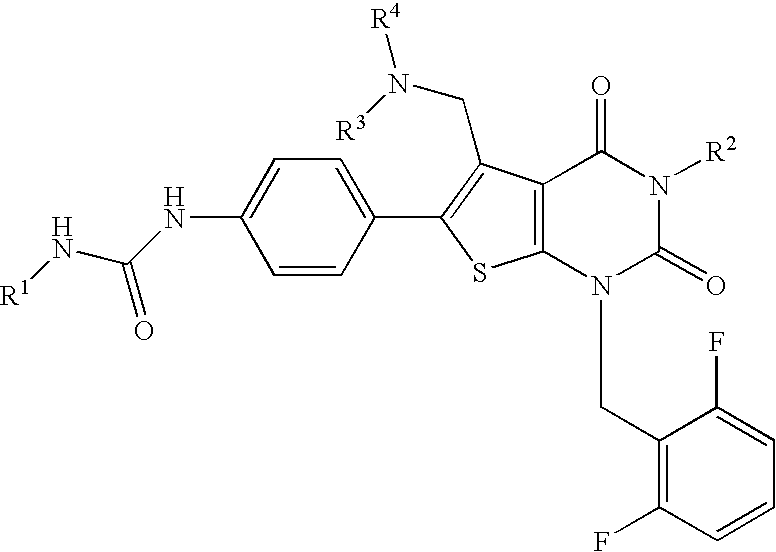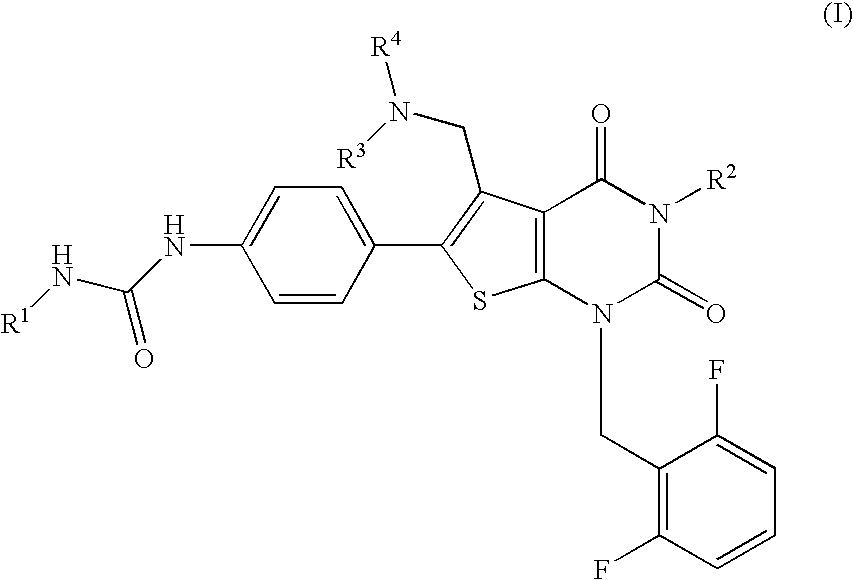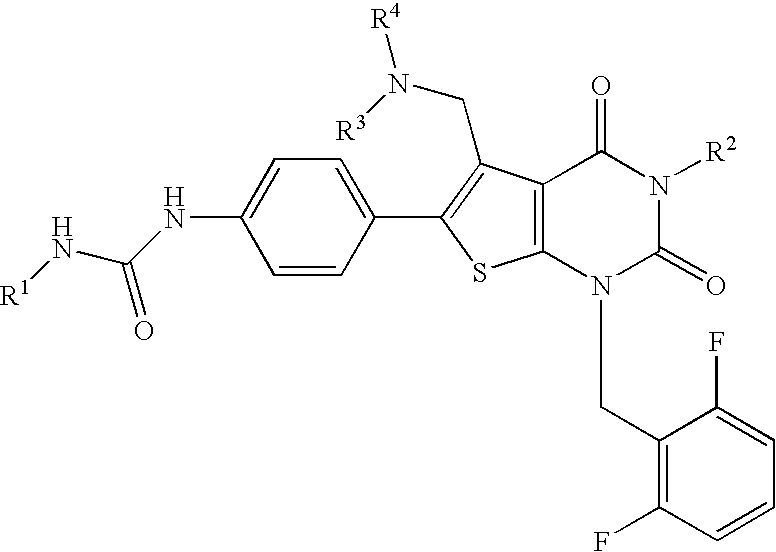Thienopyrimidines, process for preparing the same and use thereof
- Summary
- Abstract
- Description
- Claims
- Application Information
AI Technical Summary
Benefits of technology
Problems solved by technology
Method used
Image
Examples
reference example 1
Preparation of N-benzyl[1-(2,6-difluorobenzyl)-6-(4-{[(ethylamino)carbonyl]amino}phenyl)-2,4-dioxo-3-phenyl-1,2,3,4-tetrahydrothieno[2,3-d]pyrimidin-5-yl]-N,N-dimethylmethane aluminum iodide
[0187]
[0188] N-(4-(5-{[benzyl(methyl)amino]methyl)-1-(2,6-difluorobenzyl)-3-phenyl-2,4-dioxo-1,2,3,4-tetrahydrothieno[2,3-d]pyrimidin-6-yl}phenyl)-N′-ethylurea (JP-A-2001-278884, WO00 / 56739) (3.33 g, 0.5 mmol) was dissolved in DMF (6 ml), followed by addition of methyl iodide (0.62 ml, 10 mmol) and the mixture was stirred at 60° C. for 1 hour and a half. The reaction solution was concentrated, followed by addition of ethyl acetate. The precipitate was washed with ethyl acetate and diethyl ether to give the title compound (4.01 g, 99%) as light yellow powder.
[0189]1H-NMR(CDCl3) δ: 1.20 (3H, t, J=7.2 Hz), 2.77(6H, brs), 3.25-3.30 (2H, m), 4.55 (2H, brs), 4.9-5.3 (2H,br), 5.3-5.5 (2H,br), 6.2-6.3 (1H, m), 6.94 (2H, t, J=8.4 Hz), 7.2-7.6 (14H, m), 7.70 (1H, d, J=8.4 Hz), 8.73 (1H, s).
[0190] IR (KB...
reference example 2
Preparation of 3-bromo-N-methylpropanamide
[0194]
[0195] 3-Bromopropionic acid (1.52 g, 10 mmol) was dissolved in tetrahydrofuran (20 ml), followed by addition of oxalyl chloride (0.94 ml, 11 mmol) and DMF (2 drops) and the mixture was stirred at room temperature for 1 hour. The reaction solution was concentrated under reduced pressure and then was dissolved in tetrahydrofuran (20 ml), followed by addition of triethylamine (2.08 ml, 15 mmol) and a solution of methylamine in tetrahydrofuran (2 M) (6 ml, 12 mmol) and the mixture was stirred with ice-cooling for 3 hours. Saturated brine was added and the mixture was extracted with ethyl acetate. The reaction solution was dried over magnesium sulfate, and then concentrated under reduced pressure to give the title compound (0.78 g, 47%) as light yellow powder.
[0196]1H-NMR(CDCl3) δ: 2.75 (2H, t, J=6.6 Hz), 2.85 (3H, d, J=4.6 Hz), 3.65 (2H, t, J=6.6 Hz), 5.4-5.7 (1H, brm).
reference example 3
Preparation of 3-bromo-N,N-dimethylpropanamide
[0197]
[0198] The similar reaction to that of Reference Example 2 was performed using 3-bromopropionic acid (3.06 g, 20 mmol) and a solution of dimethylamine in tetrahydrofuran (2 M) (12 ml, 24 mmol) to give the title compound (2.53 g, 70%) as an orange-colored oily matter.
[0199]1H-NMR(CDCl3) δ: 2.91 (2H, t, J=7.2 Hz), 2.97 (3H, s), 2.91 (2H, t, J=7.2 Hz), 3.02 (3H, s), 3.65 (2H, t, J=7.2 Hz).
PUM
 Login to View More
Login to View More Abstract
Description
Claims
Application Information
 Login to View More
Login to View More - R&D
- Intellectual Property
- Life Sciences
- Materials
- Tech Scout
- Unparalleled Data Quality
- Higher Quality Content
- 60% Fewer Hallucinations
Browse by: Latest US Patents, China's latest patents, Technical Efficacy Thesaurus, Application Domain, Technology Topic, Popular Technical Reports.
© 2025 PatSnap. All rights reserved.Legal|Privacy policy|Modern Slavery Act Transparency Statement|Sitemap|About US| Contact US: help@patsnap.com



